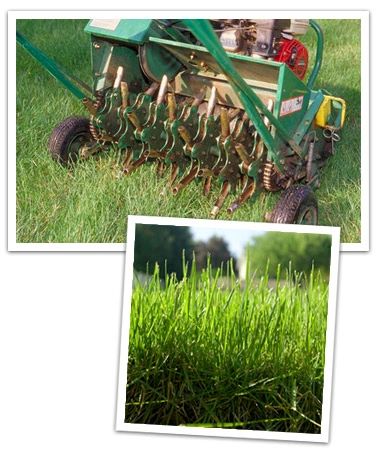~Quality service from the ground up
Core Aeration
Core aeration is the best kept secret to a great lawn!
For years turf experts have recognized that aeration is the best treatment for most problems caused by thatch and hard compacted soils. Aeration disrupts thatch and loosens the soil to improve the flow of air, water, and fertilizer.
What is aeration?
Aeration is the removal of small cores of soil that a machine pulls out of the soil. The cores are about one to two inches long. These cores are then deposited on the lawn’s surface where they will break down. Soil surrounding the plugged holes and the soil in the core will break down and collapse to fill in the holes.
When to aerate?
You can really get an aeration from March 1st all the way until November 1st. The best time to get the aeration done is between March 1st and May 1st if you want spring aeration. If you want to aeration in the fall, a good time is between early September to November 1st.
How often:
Core aeration should be done at least once per year. Here in Indiana it is necessary to aerate every year because of the soil we have. The soil has a lot of clay in it that makes our ground very compact. It is best to aerate in the spring and/or fall. One time a year is necessary, but it is beneficial to aerate twice per year.
Why should you aerate your lawn?
Lawn aeration is a very important tool in making your lawn healthy. Aeration involves making holes in the lawn by extracting a plug of soil. By aerating your lawn, you are giving it and the root many benefits, which include:
- Allows water, fertilizer, and air to enter the root system
- Increases water retention and lowers water bill
- Stimulates new root growth
- Reduces the thatch layer which suffocates the lawn
- Oxygen gets to the soil and roots
- Water is able to soak the soil and reach the roots
- Applied fertilizers and nutrients gain easy access to the roots
- Compacted soil is loosened up allowing the root and grass to grow
When should you use a lawn aerator?
The best times and most recommended times to aerate your lawn are in the spring and fall. If you are going to overseed your lawn, the most beneficial time is in the fall. It also breaks up the compacted soil after heavy use during the summer season. During the fall, roots of grass grow quickly, so the extra space, air and water will assist with root growth before the grass goes dormant for the winter. The spring is a good time to aerate to jump-start the lawn rejuvenation from the dormant winter months. It allows fertilizer you add to your lawn to get to the roots.

How do you prepare your lawn for aeration?
After aeration is complete, you can either leave the cores intact or break them up and settle them back into your lawn. Immediately watering of your lawn after aerating will help the lawn recover from the stress of aerating.
Don’t worry about the plugs:
The aerifying process will leave plugs of thatch and soil on the lawn. The soil contains microorganisms that will help begin the breakdown of thatch tissue. Do not remove these plugs !They will decompose in a few weeks. Continue to mow and water your lawn normally.


